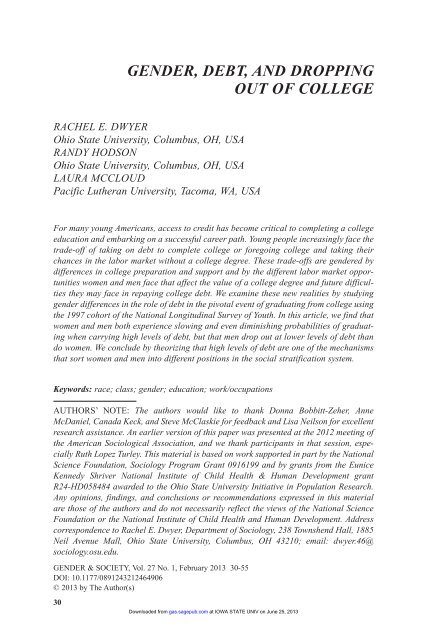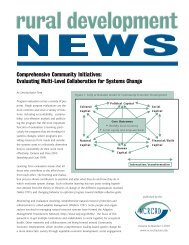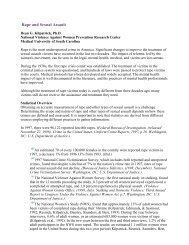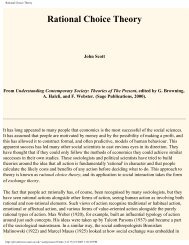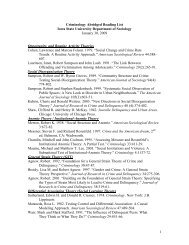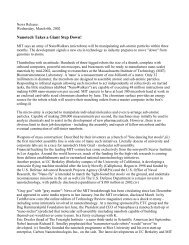Gender, debt, and droppinG out of ColleGe - Department of Sociology
Gender, debt, and droppinG out of ColleGe - Department of Sociology
Gender, debt, and droppinG out of ColleGe - Department of Sociology
You also want an ePaper? Increase the reach of your titles
YUMPU automatically turns print PDFs into web optimized ePapers that Google loves.
<strong>Gender</strong>, Debt, <strong>and</strong> DroppingOut <strong>of</strong> CollegeRachel E. DwyerOhio State University, Columbus, OH, USAR<strong>and</strong>y HodsonOhio State University, Columbus, OH, USALaura McCloudPacific Lutheran University, Tacoma, wa, USAFor many young Americans, access to credit has become critical to completing a collegeeducation <strong>and</strong> embarking on a successful career path. Young people increasingly face thetrade-<strong>of</strong>f <strong>of</strong> taking on <strong>debt</strong> to complete college or foregoing college <strong>and</strong> taking theirchances in the labor market with<strong>out</strong> a college degree. These trade-<strong>of</strong>fs are gendered bydifferences in college preparation <strong>and</strong> support <strong>and</strong> by the different labor market opportunitieswomen <strong>and</strong> men face that affect the value <strong>of</strong> a college degree <strong>and</strong> future difficultiesthey may face in repaying college <strong>debt</strong>. We examine these new realities by studyinggender differences in the role <strong>of</strong> <strong>debt</strong> in the pivotal event <strong>of</strong> graduating from college usingthe 1997 cohort <strong>of</strong> the National Longitudinal Survey <strong>of</strong> Y<strong>out</strong>h. In this article, we find thatwomen <strong>and</strong> men both experience slowing <strong>and</strong> even diminishing probabilities <strong>of</strong> graduatingwhen carrying high levels <strong>of</strong> <strong>debt</strong>, but that men drop <strong>out</strong> at lower levels <strong>of</strong> <strong>debt</strong> th<strong>and</strong>o women. We conclude by theorizing that high levels <strong>of</strong> <strong>debt</strong> are one <strong>of</strong> the mechanismsthat sort women <strong>and</strong> men into different positions in the social stratification system.Keywords: race; class; gender; education; work/occupationsAUTHORS’ NOTE: The authors would like to thank Donna Bobbitt-Zeher, AnneMcDaniel, Canada Keck, <strong>and</strong> Steve McClaskie for feedback <strong>and</strong> Lisa Neilson for excellentresearch assistance. An earlier version <strong>of</strong> this paper was presented at the 2012 meeting <strong>of</strong>the American Sociological Association, <strong>and</strong> we thank participants in that session, especiallyRuth Lopez Turley. This material is based on work supported in part by the NationalScience Foundation, <strong>Sociology</strong> Program Grant 0916199 <strong>and</strong> by grants from the EuniceKennedy Shriver National Institute <strong>of</strong> Child Health & Human Development grantR24-HD058484 awarded to the Ohio State University Initiative in Population Research.Any opinions, findings, <strong>and</strong> conclusions or recommendations expressed in this materialare those <strong>of</strong> the authors <strong>and</strong> do not necessarily reflect the views <strong>of</strong> the National ScienceFoundation or the National Institute <strong>of</strong> Child Health <strong>and</strong> Human Development. Addresscorrespondence to Rachel E. Dwyer, <strong>Department</strong> <strong>of</strong> <strong>Sociology</strong>, 238 Townshend Hall, 1885Neil Avenue Mall, Ohio State University, Columbus, OH 43210; email: dwyer.46@sociology.osu.edu.GENDER & SOCIETY, Vol. 27 No. 1, February 2013 30-55DOI: 10.1177/0891243212464906© 2013 by The Author(s)30Downloaded from gas.sagepub.com at IOWA STATE UNIV on June 25, 2013
Dwyer et al. / GENDER, DEBT, AND DROPPING OUT 31Higher education was once considered a public good that was a priorityfor society, but it is increasingly seen as a private good that should beindividually financed. One unintended consequence is that many morestudents have to take on <strong>debt</strong> to finance a college degree (Baum <strong>and</strong>McPherson 2008). In this context <strong>of</strong> heightened borrowing, <strong>debt</strong> hasbecome integral to educational attainment <strong>and</strong> the college experience formany young adults. The societal decision to finance higher education with<strong>debt</strong> shifts the risk <strong>of</strong> investing in college to individuals, with potentiallyperverse consequences. While parents <strong>and</strong> higher education administrators<strong>of</strong>ten see the opportunities <strong>and</strong> risks <strong>of</strong> taking on student loans asclearly in favor <strong>of</strong> a college degree—even with <strong>debt</strong>—there exist real risksto starting adulthood with a substantial burden <strong>of</strong> <strong>debt</strong> (Bowen, Chingos,<strong>and</strong> McPherson 2009; Leicht <strong>and</strong> Fitzgerald 2006; Rosenbaum 2001).Personal troubles like job loss, divorce, <strong>and</strong> illness <strong>of</strong>ten cannot be anticipated,<strong>and</strong> <strong>debt</strong> can make these difficulties harder to navigate (Drentea2000; Sullivan, Warren, <strong>and</strong> Westbrook 2000; McCloud <strong>and</strong> Dwyer 2011).The transition to adulthood is itself increasingly uncertain, with recentcohorts facing a less clear path into careers, family formation, <strong>and</strong> homeownership than earlier generations (Bernhardt et al. 2001; Mortimer2003). These uncertainties make a college degree ever more crucial tosecuring a place in the middle class, but they also raise the potential risk<strong>of</strong> carrying <strong>debt</strong>.These risks are significantly differentiated by gender, however, aswomen <strong>and</strong> men face different material trade-<strong>of</strong>fs <strong>and</strong> nonmaterial influenceson educational attainment <strong>and</strong> the early career (Aronson 2008). Atthe same time that higher education has transformed from a quasi-publicto a quasi-private good, women have become an increasing majority <strong>of</strong>college students. The female numeric advantage is even more pronouncedat graduation, as men not only enroll in lower numbers than women butdrop <strong>out</strong> in greater numbers (Buchmann <strong>and</strong> DiPrete 2006). Given thisevidence that women <strong>and</strong> men traverse the terrain <strong>of</strong> <strong>debt</strong>-financed highereducation differently, it is important to underst<strong>and</strong> gender differences inthe role <strong>of</strong> <strong>debt</strong> in college attrition. We examine the role <strong>of</strong> <strong>debt</strong> in dropping<strong>out</strong> <strong>of</strong> college for women <strong>and</strong> men in order to investigate genderdifferences in the system <strong>of</strong> <strong>debt</strong>-financed higher education. We expectsignificant gender differences because young women <strong>and</strong> men face differentopportunities <strong>and</strong> constraints in the uncertain risks <strong>and</strong> rewards <strong>of</strong>making their way in a <strong>debt</strong>-based society.Financing college is not usually seen as a gendered problem, but once<strong>debt</strong> is seen as one <strong>of</strong> the trade-<strong>of</strong>fs young adults make in the course <strong>of</strong>the transition to adulthood, it becomes clear that gender may shape theseDownloaded from gas.sagepub.com at IOWA STATE UNIV on June 25, 2013
32 GENDER & SOCIETY / February 2013calculations. Women <strong>and</strong> men face different labor market opportunities<strong>and</strong> so their assessments <strong>of</strong> whether <strong>debt</strong> is worth the eventual goal <strong>of</strong> acollege degree can easily differ. Occupational segregation <strong>and</strong> the genderpay gap for women are especially large among jobs that do not require acollege degree, <strong>and</strong> so women experience a greater relative college premiumthan men (Bobbitt-Zeher 2007; DiPrete <strong>and</strong> Buchmann 2006;Engl<strong>and</strong> 2010). Women may feel more pressured to take on <strong>debt</strong> to financecollege than men because women have fewer options for decent pay in jobsthat do not require a college degree. <strong>Gender</strong> differences in the role <strong>of</strong> <strong>debt</strong>in college attainment may arise for reasons other than material trade-<strong>of</strong>fsas well. Women <strong>and</strong> men differ in many <strong>of</strong> the nonmaterial influences oncollege attrition, including academic preparation, family support, <strong>and</strong> peernetworks (Tinto 1987). Institutional support varies by gender even for studentsenrolled in the same college because <strong>of</strong> persistent gender differencesin majors <strong>and</strong> extracurricular activities that may create differences in thecontacts <strong>and</strong> contexts for female <strong>and</strong> male college students (Charles <strong>and</strong>Bradley 2009; Fox, Sonnert, <strong>and</strong> Nikiforova 2011). What is less wellunderstood is whether these gender differences in experiences then translateinto different likelihoods <strong>of</strong> taking on <strong>debt</strong> to complete a collegedegree. To the extent that this translation occurs, a nonmaterial processbecomes a material difference in financial behavior.The increasing female advantage in college completion shows clearprogress for women that represents real improvements in girls’ education<strong>and</strong> family investment in girls (Buchmann <strong>and</strong> DiPrete 2006). At the sametime, women may attend college at higher rates because they have feweroptions in the low-education labor market than do men (Bobbitt-Zeher2007). One unacknowledged consequence may be gender differences inthe role <strong>of</strong> <strong>debt</strong> in supporting adult attainments. In the analysis that follows,we investigate this process with a two-stage model in which wefirst consider the effects <strong>of</strong> carrying <strong>debt</strong> on graduation probabilities forwomen <strong>and</strong> men. Subsequently, we examine the different labor marketopportunities facing female <strong>and</strong> male college graduates <strong>and</strong> drop<strong>out</strong>s as apotential lens for underst<strong>and</strong>ing gendered <strong>debt</strong> effects on graduation. Thisanalysis has the potential to shed new light not only on the new <strong>debt</strong> society,but also on the widely recognized but not fully understood surge incollege attendance <strong>and</strong> completion for women.GENDER, DEBT, AND DROPPING OUT OF COLLEGEYoung women <strong>and</strong> men have broadly equal access to <strong>debt</strong>, but the decision<strong>of</strong> whether <strong>and</strong> how to use it occurs within the constraint <strong>of</strong> genderedDownloaded from gas.sagepub.com at IOWA STATE UNIV on June 25, 2013
Dwyer et al. / GENDER, DEBT, AND DROPPING OUT 33educational <strong>and</strong> labor market opportunities. Those constraints developwithin the gender system, which shapes educational attainment <strong>and</strong> the earlycareer in multiple ways through individual, interactional, <strong>and</strong> institutionalprocesses (Risman 2004). When institutional arrangements, like the financing<strong>of</strong> higher education, change, the consequences ripple through the genderstructure <strong>and</strong> affect gendered organizations like colleges to produce potentiallydifferent implications for women <strong>and</strong> men (Acker 1990). We expectthat the effect <strong>of</strong> <strong>debt</strong> on the odds <strong>of</strong> dropping <strong>out</strong> <strong>of</strong> college operatesdifferently for men compared to women because <strong>of</strong> gender differences incollege experience <strong>and</strong> preparation <strong>and</strong> gender differences in labor marketopportunities, both <strong>of</strong> which affect the pathway to a college degree inways that may lead to a different role for <strong>debt</strong> in college attainment forwomen compared to men. We therefore see <strong>debt</strong> playing a new <strong>and</strong> potentiallyimportant role in the gendered structure <strong>of</strong> status attainment in theAmerican mobility regime.Scholars point to a range <strong>of</strong> factors in the gendered opportunity structurethat contribute to women’s increased chances <strong>of</strong> completing collegecompared to men that may also shape the influence <strong>of</strong> <strong>debt</strong> by gender.Differences in gender socialization have contributed to a persistent gendergap in academic achievement so that girls have long received highergrades on average than boys both in high school <strong>and</strong> college, <strong>and</strong> appearto have higher levels <strong>of</strong> skills <strong>and</strong> other predictors <strong>of</strong> academic performance,including self-discipline, attentiveness, <strong>and</strong> taking college preparatorycourses (Buchmann, DiPrete, <strong>and</strong> McDaniel 2008; Downey <strong>and</strong>Vogt-Yuan 2005). As families have shifted to value educational investmentsin both girls <strong>and</strong> boys as a result <strong>of</strong> the spread <strong>of</strong> more egalitarianvalues <strong>and</strong> increasing incentives for women to complete a degree, thefemale-favorable gender gap in achievement appears to have been translatedinto female-favorable college enrollment <strong>and</strong> completion (Buchmann<strong>and</strong> DiPrete 2006). These differences in academic preparation <strong>and</strong> supportmay put women in a position to better leverage access to credit to achievecollege completion.<strong>Gender</strong> inequality in the labor market <strong>and</strong> in marriage may also leadwomen to consider <strong>debt</strong> a better investment in order to attain higher educationthan men. Women <strong>and</strong> men are more occupationally segregated inlow-education jobs than in high-education jobs, making the gender paygap particularly severe at the bottom <strong>of</strong> the labor market. Engl<strong>and</strong> (2010)shows, for example, that working-class jobs saw only a slight decline ingender segregation from 1950 to 2000, even as middle-class jobs requiringa college degree desegregated significantly. Because low-education jobsfor women are so poorly paid, women gain relatively more from attendingDownloaded from gas.sagepub.com at IOWA STATE UNIV on June 25, 2013
34 GENDER & SOCIETY / February 2013college than do men. The gain in pay for female college graduates comparedto less educated women is much greater than the gain in pay for malecollege graduates compared to less educated men (Bobbitt-Zeher 2007;DiPrete <strong>and</strong> Buchmann 2006). Even though college-bound women continueto concentrate in majors that lead to careers with lower wages thanmen, women’s prospects in the low-education labor market are even moredismal (Charles <strong>and</strong> Grusky 2004; Fox, Sonnert, <strong>and</strong> Nikiforova 2011;Wilson <strong>and</strong> Boldizar 1990).The gendered job structure may also contribute to these patterns, asthe most female-typed occupations—such as teaching <strong>and</strong> nursing—thatare aspired to by many young women all require a college degree.<strong>Gender</strong> essentialist beliefs that women are well suited to careers in carework <strong>and</strong> human development may lead women to value a collegedegree—even with <strong>debt</strong>—by seeing a college education as especiallyimportant in forming an adult female occupational identity (Charles <strong>and</strong>Bradley 2009; Ridgeway <strong>and</strong> Correll 2004). Women tend to hold aspirations<strong>of</strong> making a difference <strong>and</strong> caring for others in their careers,whereas men are more likely to prioritize the material rewards <strong>of</strong> jobs(Wilson <strong>and</strong> Boldizar 1990). Accordingly, a college degree becomes evenmore important for women in order to achieve personally meaningfulcareers than it is for men. Staying in college may thus pay nonmaterialdividends to women because <strong>of</strong> gender ideologies ab<strong>out</strong> the relationshipbetween work <strong>and</strong> identity. 1 Women also appear to gain more from marriagewhen they have a college degree, <strong>and</strong> more so over time withincreasing class homogamy (DiPrete <strong>and</strong> Buchmann 2006). <strong>Gender</strong> differencesin these material <strong>and</strong> nonmaterial trade-<strong>of</strong>fs may make womenmore dependent on a college degree, <strong>and</strong> thereby more dependent on <strong>debt</strong>in the context <strong>of</strong> rising tuitions.RESEARCH QUESTIONSWe test our expectations ab<strong>out</strong> gender differences in <strong>debt</strong> <strong>and</strong> collegecompletion by considering two issues. First, we analyze the role <strong>of</strong> studentloans in college completion for women compared to men. Second, weexamine early career <strong>out</strong>comes for female <strong>and</strong> male drop<strong>out</strong>s <strong>and</strong> collegecompleters as a potential explanation for gendered <strong>debt</strong> effects.<strong>Gender</strong> <strong>and</strong> Student LoansWe conceptualize taking on student loan <strong>debt</strong> to achieve a collegedegree as an investment, but an investment with risks because <strong>of</strong> theDownloaded from gas.sagepub.com at IOWA STATE UNIV on June 25, 2013
Dwyer et al. / GENDER, DEBT, AND DROPPING OUT 35uncertainties <strong>of</strong> being able to pay back the <strong>debt</strong> in the future, risk that wehave argued vary by gender. We expect that this double-edged character<strong>of</strong> <strong>debt</strong> means that different amounts <strong>of</strong> <strong>debt</strong> will have different effects onthe likelihood <strong>of</strong> college completion (Dwyer, McCloud, <strong>and</strong> Hodson2012). Educational loans likely reduce the chances <strong>of</strong> dropping <strong>out</strong> atlower levels <strong>of</strong> <strong>debt</strong>, helping students through difficult periods <strong>and</strong> servingas a bridge over shortfalls from other sources <strong>of</strong> funding (Chen <strong>and</strong>DesJardins 2008; Dwyer, McCloud, <strong>and</strong> Hodson 2011). As educational<strong>debt</strong> reaches higher levels, however, it can generate increasing pressure todrop <strong>out</strong> (Ishitani 2006). Many students enter college relatively uninformedab<strong>out</strong> <strong>debt</strong> <strong>and</strong> may take on large amounts <strong>of</strong> <strong>debt</strong> with<strong>out</strong> thinking<strong>of</strong> the consequences until later in their college career as repaymentlooms (Bowen, Chingos, <strong>and</strong> McPherson 2009). Indeed, student concernab<strong>out</strong> <strong>debt</strong> appears to build over the course <strong>of</strong> college as <strong>debt</strong> mounts <strong>and</strong>postcollege realities come into sharper focus—realities that can includenegative <strong>out</strong>comes like depression <strong>and</strong> suicidal ideation in addition todropping <strong>out</strong> <strong>of</strong> college (Meltzer et al. 2011). Other students may get into<strong>debt</strong> because <strong>of</strong> personal problems or an unexpected decline in familysupport that makes it difficult to continue in college with<strong>out</strong> extensiveborrowing (Christie <strong>and</strong> Munro 2003). We expect that the gender differencesin college experiences <strong>and</strong> labor market expectations discussedabove will affect these mechanisms <strong>and</strong> the balance between risk <strong>and</strong>reward in taking on more <strong>debt</strong>.Prior research has given almost no attention to gender differences in therole <strong>of</strong> <strong>debt</strong> in college attainment. Yet to the extent that women are betterprepared <strong>and</strong> receive greater social support for college, <strong>and</strong> see moreadvantages to staying in college compared to dropping <strong>out</strong>, women shouldbe willing to take on more educational <strong>debt</strong> to stay in college than men.Young men who see high school friends with relatively well-paying jobsmay resist taking on <strong>debt</strong> to gain a degree with uncertain returns. Theymay ignore or discount some <strong>of</strong> the longer-term negatives <strong>of</strong> traditionalmale blue-collar jobs, such as the risk <strong>of</strong> unemployment <strong>and</strong> industrialdecline. At the same time, young women who see friends in low-payingfemale-dominated jobs, such as retail cashier or day care worker, may bespurred to stay in school, even with <strong>debt</strong>. The motivation to continue incollege in spite <strong>of</strong> <strong>debt</strong> is thus likely more pressing for women than formen. We can test these expectations by studying the differential effects <strong>of</strong><strong>debt</strong> on dropping <strong>out</strong> <strong>of</strong> college for women <strong>and</strong> men. We expect that bothwomen <strong>and</strong> men will evidence a nonlinear effect <strong>of</strong> <strong>debt</strong>—with <strong>debt</strong>increasing the chances <strong>of</strong> graduating at lower levels <strong>and</strong> leveling <strong>out</strong> orDownloaded from gas.sagepub.com at IOWA STATE UNIV on June 25, 2013
36 GENDER & SOCIETY / February 2013declining at higher levels. But we expect that men will drop <strong>out</strong> at lowerlevels <strong>of</strong> <strong>debt</strong>—because, more <strong>of</strong>ten than women, they will make the calculationthat higher levels <strong>of</strong> <strong>debt</strong> are “not worth it.”Hypothesis 1: The effect <strong>of</strong> educational loans on graduation will benonlinear—first positive at lower levels <strong>of</strong> <strong>debt</strong> <strong>and</strong> then negative athigher levels <strong>of</strong> <strong>debt</strong> for both women <strong>and</strong> men.Hypothesis 1a: Lower levels <strong>of</strong> educational <strong>debt</strong> will increase the chances<strong>of</strong> graduating more for women than for men because <strong>of</strong> differences inmaterial trade-<strong>of</strong>fs <strong>and</strong> nonmaterial support <strong>and</strong> expectations.Hypothesis 1b: Higher levels <strong>of</strong> educational <strong>debt</strong> will be more <strong>of</strong> adeterrent to completion for men than women, so that the negativeeffect <strong>of</strong> high <strong>debt</strong> on dropping <strong>out</strong> will occur at lower levels <strong>of</strong> <strong>debt</strong>for men compared to women.Early Career OutcomesWe propose that gender differences in the role <strong>of</strong> <strong>debt</strong> in college completionreflect a gendered opportunity structure that increases the incentives<strong>of</strong> a college degree for women compared to men for a range <strong>of</strong> material <strong>and</strong>cultural reasons. Because we use longitudinal data on a cohort <strong>of</strong> youngadults, we can analyze gender differences in early career <strong>out</strong>comes for thewomen <strong>and</strong> men in our sample after their college experiences. This allowsus to evaluate gender differences in the opportunity structure faced at theseyoung ages that, we posit, shape decisions ab<strong>out</strong> <strong>debt</strong> <strong>and</strong> dropping <strong>out</strong>. Itis especially important to examine these very early career <strong>out</strong>comes thatare most likely to impact decisions while in college.Prior research suggests that students do consider their labor market opportunitieswhen deciding whether to attend <strong>and</strong> complete college. Bozick (2007)shows that y<strong>out</strong>h living in places with a labor market with a high proportion<strong>of</strong> jobs requiring a college degree are more likely to go to college than arey<strong>out</strong>h living in places with more jobs that do not require a college degree.Y<strong>out</strong>h are similarly sensitive to levels <strong>of</strong> unemployment <strong>and</strong> job growth(Bozick 2007). Of course, students do not have perfect information ab<strong>out</strong>labor market opportunities, <strong>and</strong> their decisions to stay <strong>and</strong> finish college versusdropping <strong>out</strong> are affected by many factors. But students appear sensitiveto the balance between their financial resources <strong>and</strong> probable labor marketopportunities in deciding to complete a college degree, <strong>and</strong> we argue thatgendered opportunities make this a fundamentally gender-differentiatedexperience.Downloaded from gas.sagepub.com at IOWA STATE UNIV on June 25, 2013
Dwyer et al. / GENDER, DEBT, AND DROPPING OUT 37Hypothesis 2a: Female college drop<strong>out</strong>s will have significantly lowerearnings than female college graduates in their early career because<strong>of</strong> occupational segregation <strong>and</strong> low pay for female-dominated jobsthat do not require a college degree.Hypothesis 2b: Male college drop<strong>out</strong>s will have similar earnings to malecollege graduates in their early career because the job opportunitiesfor low-skilled men are relatively better than for low-skilled women.DATA AND METHODSWe use data from the National Longitudinal Survey <strong>of</strong> Y<strong>out</strong>h, 1997Cohort (NLSY97), to examine the effect in<strong>debt</strong>edness has on youngadults’ likelihood <strong>of</strong> graduating from college. The NLSY97 is an annuallyadministered survey funded by the Bureau <strong>of</strong> Labor Statistics (BLS) thatconsists <strong>of</strong> two subsamples <strong>of</strong> young adults born between 1980 <strong>and</strong> 1984;the first subsample is a nationally representative sample <strong>of</strong> 6,748 youngadults <strong>and</strong> the second subsample oversamples 2,236 Hispanic <strong>and</strong> Blackindividuals. The first year <strong>of</strong> data collection for this NLSY cohort was1996, <strong>and</strong> the latest round <strong>of</strong> data available for our analysis was collectedin 2010-2011. At the time <strong>of</strong> the latest available data, the young adults inour sample range in age from 25 to 31 years old, with a mean <strong>of</strong> 28 years.The NLSY97 is an optimal data set for our study because it has rich financialdata on the cohort <strong>of</strong> young people who became adults following thedemocratization <strong>of</strong> credit in the 1990s.In our first analysis, we use event history models to assess the relationshipbetween <strong>debt</strong> <strong>and</strong> college completion. We take a discrete time eventhistory approach in which the sample is composed <strong>of</strong> people who wereenrolled in a four-year college in a given year <strong>and</strong> are thereby “at risk” <strong>of</strong>graduating from college in that year. This results in a sample <strong>of</strong> 29,081person-years across the 13 survey years included in our analysis. Our sampleincludes 3,676 individual respondents, with a median <strong>of</strong> 8 years <strong>of</strong>observation for each respondent. The dependent variable is a binary indicator<strong>of</strong> whether the respondent graduated from a four-year college in thecurrent year. In event history parlance, graduation is the “failure” event,<strong>and</strong> the model coefficients represent the “hazard” <strong>of</strong> failure, though we willfor the most part not use this language. Duration to failure (graduation) <strong>and</strong>risk <strong>of</strong> failure are two ways <strong>of</strong> thinking ab<strong>out</strong> what the coefficients meanin a general sense—if being female increases the risk <strong>of</strong> graduation in anygiven period, it also means that being female reduces time to degree.However, because the coefficients have the same form as in a logisticDownloaded from gas.sagepub.com at IOWA STATE UNIV on June 25, 2013
38 GENDER & SOCIETY / February 2013regression analysis, we will discuss odds ratios in reporting our results.These models require a measure <strong>of</strong> the duration-dependence <strong>of</strong> thehazard in order to control for the “baseline” risk <strong>of</strong> graduating in a particularyear, which varies by how long a person has been enrolled in college.In other words, those who have been in college longer have a greater risk<strong>of</strong> graduating than those who just entered college. We use a linear durationterm in the models we present in this article, but in supplemental analyseswe also tested the possibility that duration has a nonlinear effect. A cubicterm for duration is significant, but the model fit does not improve much<strong>and</strong> so we use the linear term for ease <strong>of</strong> interpretation.We measure educational <strong>debt</strong> as student loans taken in each year therespondent is enrolled in college. The initial question is “Other than assistanceyou received from relatives <strong>and</strong> friends, how much did you borrow ingovernment-subsidized loans or other types <strong>of</strong> loans while you attended thisschool/institution?” <strong>and</strong> a follow-up question asks how much is still owedon the loan. The amount owed refers to the remaining balance on the loanamount borrowed that year. For most respondents, the amount borrowed<strong>and</strong> owed are quite similar, but we use the owed quantity to exclude <strong>debt</strong>that was immediately repaid. We expect that these quickly repaid loans areless likely to affect graduation probabilities (they likely include unspentfunds), <strong>and</strong> indeed, supplemental analyses using the total amount borrowedshow a similar pattern <strong>of</strong> results to the main analyses here. We top-code thevariable at $20,000, which is the 99th percentile for the variable across allyears. Because we hypothesize that the impact <strong>of</strong> education <strong>debt</strong> is nonlinear,we include a squared term for education <strong>debt</strong>, expecting a quadraticeffect <strong>of</strong> first increasing <strong>and</strong> then decreasing odds <strong>of</strong> graduating. 1We include several control variables. We measure respondents’ socialclass <strong>of</strong> origin in order to capture differences in the effect <strong>of</strong> in<strong>debt</strong>ednesson college completion by family resources. We define respondent classst<strong>and</strong>ing using parental household income in 1996 (the first year <strong>of</strong> datacollection), which is the sum <strong>of</strong> the income <strong>of</strong> the respondent’s mother<strong>and</strong> father (or mother’s spouse or cohabiting partner at the time). Wedivide respondents into three categories based on the position <strong>of</strong> parentalincome in the 1996 national income distribution: upper income if in thetop quartile, middle income if in the middle two quartiles, <strong>and</strong> lowerincome if in the bottom quartile. We use parental income to construct themeasures <strong>of</strong> social class because we believe the class st<strong>and</strong>ing <strong>of</strong> youngadults is best represented by their social origins rather than by their currentpersonal income. We test an alternative measure using parental education<strong>and</strong> find similar results.Downloaded from gas.sagepub.com at IOWA STATE UNIV on June 25, 2013
Dwyer et al. / GENDER, DEBT, AND DROPPING OUT 39We additionally control for race/ethnicity, with categories for white,Black, <strong>and</strong> Hispanic. Because the NLSY does not oversample the Asianpopulation, we drop the small sample <strong>of</strong> respondents who identify asAsian from the main analysis but supplemental analyses show a similarpattern <strong>of</strong> results when these respondents are included as a separate category.We control for high school grade point average in order to capturedifferences in educational achievement, which may affect the relationshipbetween <strong>debt</strong> <strong>and</strong> college completion. 2 Indicators for parenthood,<strong>and</strong> whether married or cohabiting, measure the influence <strong>of</strong> familyarrangements on <strong>debt</strong> <strong>and</strong> college graduation (Bozick 2007). 3 We alsocontrol for important features <strong>of</strong> the college experience, includingwhether or not the respondent was enrolled part-time <strong>and</strong> whether theyattended a public or private college. Descriptive statistics are reported inthe appendix.In the second part <strong>of</strong> the analysis, we consider the earnings <strong>and</strong> occupationaldestinations <strong>of</strong> female <strong>and</strong> male college graduates <strong>and</strong> drop<strong>out</strong>sin their early career as a potential explanation for gender differences in<strong>debt</strong> effects on college graduation. The sample for these models includesemployed respondents who are not enrolled in school but who haveattended a four-year college at some point, with employment <strong>and</strong> schoolstatus measured at the end <strong>of</strong> our data series. Here we include only oneunit per respondent (rather than multiple years) in order to estimate earlycareer <strong>out</strong>comes rather than employment fluctuations while respondentsare still engaged in schooling. In these models we control for respondentcharacteristics that are especially relevant for labor force participation <strong>and</strong>choices, including class background, race, whether a parent, <strong>and</strong> whethermarried or cohabiting.We consider the NLSY97 the very highest quality data available tostudy gender differences in <strong>debt</strong> <strong>and</strong> dropping <strong>out</strong>, but, like all studies, thisanalysis has limitations. The sample is relatively young <strong>and</strong> so we are notable to discern gender differences in the role <strong>of</strong> <strong>debt</strong> for students returningto college in mid-life, in their 30s or older. Even so, nontraditional studentsface a range <strong>of</strong> distinctive issues in <strong>debt</strong> <strong>and</strong> movement throughcollege that may make a separate analysis <strong>of</strong> that group most appropriate.As the NLSY97 cohort ages, we will have the opportunity to consider thegendered role <strong>of</strong> <strong>debt</strong> in college completion for older students. We als<strong>of</strong>ace the challenge <strong>of</strong> possible selection bias, as in all observational studies.Students who are most likely to take on a large amount <strong>of</strong> <strong>debt</strong> mayalso be most likely to drop <strong>out</strong>, <strong>and</strong> so <strong>debt</strong> may not be so much a directcause <strong>of</strong> dropping <strong>out</strong> as it is a fellow traveler in a set <strong>of</strong> behaviors thatimpede attainment. Students who have difficulty with self-regulation may,for example, take on <strong>debt</strong> carelessly <strong>and</strong> at the same time face challengesDownloaded from gas.sagepub.com at IOWA STATE UNIV on June 25, 2013
40 GENDER & SOCIETY / February 2013TABLE 1: Annual Educational Loans Taken by College Students in theNLSY97All Women MenPercent with <strong>debt</strong> 37.7% 40.4% 34.4%Mean <strong>debt</strong> $1,757 $1,874 $1,614Mean <strong>debt</strong> for <strong>debt</strong> holders only $4,719 $4,726 $4,709N (person-years) 29,081 16,068 13,013Source: National Longitudinal Study <strong>of</strong> Y<strong>out</strong>h, 1997 Cohort.Notes: Sample is all students currently enrolled in a four-year college. Descriptive results inthis table are weighted.in keeping up with classes. We have taken steps to address the possibility<strong>of</strong> selection bias by using longitudinal methods <strong>and</strong> including controls inour regression model, but these are only partial solutions. Even to theextent that <strong>debt</strong> hitches a ride on other troubles, however, it is still a materialfinancial obligation that is not easily discharged <strong>and</strong> thus becomesvery real in its effects. Thus, we contend that even the weaker hypothesis<strong>of</strong> high levels <strong>of</strong> <strong>debt</strong> being associated with other troubles in collegeattainment is highly significant because students who already face challengesin their educational efforts now have the additional burden <strong>of</strong> highin<strong>debt</strong>edness.RESULTSThe prevalence <strong>and</strong> amount <strong>of</strong> student loans taken <strong>out</strong> each year bycollege students in this nationally representative sample are reported inTable 1. Ab<strong>out</strong> 38 percent <strong>of</strong> those enrolled take on educational loans in agiven year. The mean educational loan taken <strong>out</strong> by <strong>debt</strong>ors in a givenyear is $4,719. Women are more likely to take <strong>out</strong> loans than men, with40 percent <strong>of</strong> women <strong>and</strong> 34 percent <strong>of</strong> men taking <strong>out</strong> loans on averagein each year. These results are certainly suggestive that <strong>debt</strong>-holding is agendered experience. The mean amount <strong>of</strong> <strong>debt</strong> for men <strong>and</strong> women studentswho take on <strong>debt</strong> is quite similar, however, with women holding$4,726 <strong>and</strong> men holding $4,709. 4 A measure <strong>of</strong> cumulative <strong>debt</strong> showssimilar patterns, albeit at higher levels <strong>of</strong> <strong>debt</strong>, with almost half <strong>of</strong> all collegestudents carrying <strong>debt</strong> overall, with a somewhat larger gender differential<strong>of</strong> women carrying more <strong>debt</strong>, at $11,133, than men at $10,829. 5Clearly, educational <strong>debt</strong> was part <strong>of</strong> the college experience for manystudents in the 2000s.In Table 2, we consider two models <strong>of</strong> the likelihood <strong>of</strong> graduatingfrom college, estimated separately for women <strong>and</strong> men. Model 1 includesDownloaded from gas.sagepub.com at IOWA STATE UNIV on June 25, 2013
Dwyer et al. / GENDER, DEBT, AND DROPPING OUT 41the quadratic form <strong>of</strong> educational <strong>debt</strong> with<strong>out</strong> any covariates, <strong>and</strong> Model 2adds controls. (All models include the measure for duration <strong>of</strong> time inschool, <strong>and</strong> this variable is consistently positive associated with graduationas expected.) Starting with Model 1, <strong>and</strong> taking the results for women<strong>and</strong> men together, the findings support our expectation in Hypothesis 1that the effect <strong>of</strong> student loan <strong>debt</strong> on dropping <strong>out</strong> follows a quadraticform for both women <strong>and</strong> men. Higher levels <strong>of</strong> educational <strong>debt</strong> increasethe chance <strong>of</strong> graduating (<strong>and</strong> lower duration to graduating) until a highlevel <strong>of</strong> <strong>debt</strong> is achieved, <strong>and</strong> then additional <strong>debt</strong>s no longer increase thechances <strong>of</strong> graduating; in fact, the chances decline a bit compared to moderatelevels <strong>of</strong> <strong>debt</strong>. In supplemental tests, we verify that the quadraticeffect is not just the influence <strong>of</strong> <strong>out</strong>liers <strong>and</strong> that there is sufficient sampledensity at high levels <strong>of</strong> <strong>debt</strong> to support the quadratic effect. We alsotested the effect <strong>of</strong> <strong>debt</strong> on graduation in a nonparametric model that doesnot specify the form <strong>of</strong> the <strong>debt</strong> variable in advance, <strong>and</strong> even here we seea downturn in graduation probabilities above $10,000. Even if we think <strong>of</strong>the quadratic as modeling a flattening <strong>of</strong> the line more than a sharp downturnin the line, this is consistent with our interpretation that higheramounts <strong>of</strong> <strong>debt</strong> produce diminishing returns for college completion, <strong>and</strong>highlights the worrisome reality that many students leave college withhigh levels <strong>of</strong> <strong>debt</strong> but with<strong>out</strong> a degree.While the form <strong>of</strong> the effect is similar for women <strong>and</strong> men, there aregender differences in the level <strong>of</strong> <strong>debt</strong> where the quadratic turns negative<strong>and</strong> additional levels <strong>of</strong> <strong>debt</strong> no longer improve the chances <strong>of</strong> completingcollege. We can see these differences by calculating the inflection point <strong>of</strong>the curve for women compared to men using the coefficients reported inTable 2. In Model 1, the base model with no additional covariates besidesduration, the curve turns negative at $14,620, while for men the inflectionpoint is $12,426. As we expected, men’s graduation probabilities start t<strong>of</strong>latten at lower levels <strong>of</strong> <strong>debt</strong> than for women. This is consistent withtheories that the relative value <strong>of</strong> college is lower for men than for women,in part because <strong>of</strong> men’s better prospects in the noncollege labor market.Model 2 for women <strong>and</strong> men includes a number <strong>of</strong> known influences onthe likelihood <strong>of</strong> dropping <strong>out</strong> <strong>of</strong> college <strong>and</strong> produces effects similar to thefindings from prior research. Effects are in the same direction for women<strong>and</strong> men, though the size <strong>of</strong> the effects varies by gender, consistent withprevious studies <strong>of</strong> gender differences in higher education. Y<strong>out</strong>h fromlower-income backgrounds are no more or less likely to graduate than arey<strong>out</strong>h from middle-income backgrounds, while y<strong>out</strong>h from upperincomebackgrounds are more likely to graduate than y<strong>out</strong>h from middle-incomebackgrounds. This is consistent with observations that theDownloaded from gas.sagepub.com at IOWA STATE UNIV on June 25, 2013
TABLE 2: Discrete Time Event History Regression <strong>of</strong> Debt on College GraduationWomen MenModel 1 Model 2 Model 1 Model 2B (SE)OddsRatio B (SE) Odds Ratio B (SE)OddsRatio B (SE)OddsRatioDuration 0.635*** 1.887*** 0.694*** 2.002*** 0.608*** 1.836*** 0.656*** 1.927***(0.010) (0.019) (0.012) (0.024) (0.011) (0.020) (0.013) (0.025)Education <strong>debt</strong> 0.077*** 1.080*** 0.093*** 1.097*** 0.099*** 1.104*** 0.095*** 1.100***(0.015) (0.016) (0.016) (0.017) (0.018) (0.019) (0.019) (0.020)Education <strong>debt</strong> squared –0.003*** 0.997*** –0.003*** 0.997*** –0.004*** 0.996*** –0.004*** 0.996***(0.001) (0.001) (0.001) (0.001) (0.001) (0.001) (0.001) (0.001)Control variablesSocial class origin (middle income omitted)Lower income 0.074 1.077 0.076 1.079(0.061) (0.066) (0.071) (0.076)Upper income 0.337*** 1.401*** 0.353*** 1.423***(0.057) (0.079) (0.065) (0.092)Race (non-Hispanic white omitted)Black –0.462*** 0.630*** –0.433*** 0.649***(0.065) (0.041) (0.081) (0.053)Hispanic –0.271*** 0.762*** –0.641*** 0.527***(0.074) (0.057) (0.086) (0.045)Children –1.405*** 0.245*** –0.967*** 0.380***(0.074) (0.018) (0.103) (0.039)Married or cohabiting 0.222*** 1.249*** 0.220*** 1.247***(0.057) (0.071) (0.071) (0.088)Grade point average 0.009*** 1.009*** 0.012*** 1.012***(0.001) (0.001) (0.001) (0.001)(continued)42Downloaded from gas.sagepub.com at IOWA STATE UNIV on June 25, 2013
Table 2. (continued)Women MenModel 1 Model 2 Model 1 Model 2B (SE)OddsRatio B (SE) Odds Ratio B (SE)OddsRatio B (SE)OddsRatioEnrolled part-time –1.211*** 0.298*** –1.590*** 0.204***(0.116) (0.035) (0.142) (0.029)Enrolled in private college –0.236*** 0.790*** –0.036 0.965(0.076) (0.060) (0.091) (0.088)Intercept –3.749*** 0.024*** –6.657*** 0.001*** –3.916*** 0.020*** –7.720*** 0.000***(0.057) (0.001) (0.230) (0.000) (0.066) (0.001) (0.251) (0.000)N 16,068 16,068 13,013 13,013Source: National Longitudinal Study <strong>of</strong> Y<strong>out</strong>h, 1997 Cohort.Notes: Debt variables were measured in thous<strong>and</strong>s <strong>of</strong> dollars.***p < .001 (one-tailed).43Downloaded from gas.sagepub.com at IOWA STATE UNIV on June 25, 2013
44 GENDER & SOCIETY / February 2013lower-income-background students who attend college are a more selectgroup than y<strong>out</strong>h from middle-income backgrounds. Despite having fewerfamily resources, the average lower-income student who attends collegemay be more academically talented <strong>and</strong> motivated than the average middle-incomestudent who sees college as a normative expectation. Y<strong>out</strong>hfrom upper-income backgrounds may also see college as normative butbenefit from greater resources <strong>and</strong> perhaps superior preparation. Black <strong>and</strong>Hispanic students are less likely to graduate than white students, with theracial effect stronger for men than for women, consistent with previousresearch on racial disparities in college completion (Buchmann <strong>and</strong>DiPrete 2006). Students who enroll in college part-time or have childrenare less likely to graduate, likely because <strong>of</strong> the pulls <strong>of</strong> competingresponsibilities <strong>and</strong> dem<strong>and</strong>s on resources, while students who are marriedor cohabiting are more likely to graduate. Students with higher highschool grade point averages are more likely to graduate, consistent withresearch on educational achievement. Private school attendance is notsignificant in the full model for men, <strong>and</strong> it reduces the chances <strong>of</strong>graduating for women, which contrasts with expectations. We suspectthat this difference may reflect women disproportionately attending lessprestigious private colleges, where their graduation prospects arereduced. Importantly, we find that the gender-differentiated effects <strong>of</strong><strong>debt</strong> on dropping <strong>out</strong> <strong>of</strong> college still hold even after we control for thesecompeting influences on graduation potentials.When we add the controls in Model 2, the curvilinear effect <strong>of</strong> educational<strong>debt</strong> on graduation remains quite stable. The inflection point doesoccur at a slightly higher level for both women <strong>and</strong> men in the full modelcompared to the base model, consistent with the idea <strong>of</strong> the covariatesaccounting for some <strong>of</strong> the <strong>debt</strong> effects, but the changes are very small,with the inflection point for women at $14,682 <strong>and</strong> for men at $12,711. Thegender differential thus remains ab<strong>out</strong> the same even after controlling forfamily background <strong>and</strong> differences in college preparation <strong>and</strong> experience.The gender differences in the effect <strong>of</strong> <strong>debt</strong> on college graduation areeven more clearly illustrated in Figure 1, which graphs the predicted valuesfor the curvilinear effect <strong>of</strong> educational loans for women <strong>and</strong> men. 6The predicted values reflect the full Model 2, with all control variables setto their mean. Recall that because we are using event history models, thepredicted probability plotted on the y-axis is <strong>of</strong> graduating in a particularyear rather than the overall probability <strong>of</strong> completing college.The entire curve tracks higher for women than for men. This is consistentwith women’s greater graduation probabilities overall, but it also suggeststhat <strong>debt</strong> is a greater facilitator <strong>of</strong> graduation for women than forDownloaded from gas.sagepub.com at IOWA STATE UNIV on June 25, 2013
Dwyer et al. / GENDER, DEBT, AND DROPPING OUT 45Figure 1: Estimated probabilities <strong>of</strong> graduating from college byeducational <strong>debt</strong> for women <strong>and</strong> men enrolled in college, full modelNote: Educational <strong>debt</strong> is measured in thous<strong>and</strong>s <strong>of</strong> dollars.men. Supporting this interpretation, the curve for men tracks shallower<strong>and</strong> turns negative at lower levels <strong>of</strong> <strong>debt</strong>, indicating that educationalloans are less effective at preventing dropping <strong>out</strong> <strong>and</strong> that men drop <strong>out</strong>at lower levels <strong>of</strong> <strong>debt</strong> than do women. The gender differential thusincreases at higher levels <strong>of</strong> <strong>debt</strong>—the gender gap in graduation is lessthan 0.05 percentage point at zero <strong>debt</strong>, but close to 1.0 percentage pointat the highest levels <strong>of</strong> <strong>debt</strong>. This pattern <strong>of</strong> gender differences supportsour expectations that women <strong>and</strong> men face different pathways through<strong>debt</strong>-financed higher education, with potentially important consequencesfor their longer-term financial circumstances above <strong>and</strong> beyond the effect<strong>of</strong> college attainment. As we enunciated in Hypothesis 1a, lower levels <strong>of</strong><strong>debt</strong> increase the chances <strong>of</strong> graduating for women more than for men.The curve starts higher for women than men <strong>and</strong> stays higher along thewhole curve. At the same time, the curve turns downward at a higher level<strong>of</strong> <strong>debt</strong> for women than for men. This supports our expectation inHypothesis 1b that higher levels <strong>of</strong> <strong>debt</strong> are more strongly associated withdropping <strong>out</strong> <strong>of</strong> college for men than for women, suggesting that educa-Downloaded from gas.sagepub.com at IOWA STATE UNIV on June 25, 2013
46 GENDER & SOCIETY / February 2013tion <strong>debt</strong> becomes an impediment to completion at lower levels for menthan for women.So far we have highlighted gender differences in <strong>debt</strong> <strong>and</strong> graduation,but research on college graduation shows that there are also substantialracial differences in graduation probabilities, <strong>and</strong> that these interact significantlywith gender (Buchmann <strong>and</strong> DiPrete 2006). We examine racialdifferences within gender by studying differences in predicted probabilitiesin college graduation across levels <strong>of</strong> <strong>debt</strong> for different racial groups.We find that the curve for Black <strong>and</strong> Hispanic students tracks lower thanthe curve for white students for both men <strong>and</strong> women <strong>and</strong> that the inflectionpoint occurs at somewhat lower levels as well. At the same time,Black <strong>and</strong> Hispanic women are more likely to graduate across all levels<strong>of</strong> <strong>debt</strong> than are Black <strong>and</strong> Hispanic men. In supplemental analyses, we donot find strong interaction effects between race <strong>and</strong> <strong>debt</strong>, but we suspectthis reflects the fact that our sample becomes sparse at high levels <strong>of</strong> <strong>debt</strong>for the Black <strong>and</strong> Hispanic subgroups. Additional analysis with largersamples <strong>of</strong> minority students (including Asian students) will be necessaryin order to sort <strong>out</strong> the details <strong>of</strong> racial differences in <strong>debt</strong> <strong>and</strong> graduationby gender. The perils <strong>of</strong> dropping <strong>out</strong> <strong>of</strong> college with<strong>out</strong> a degree, but with<strong>debt</strong>, may be particularly serious for minority students who face racialdiscrimination in the labor market <strong>and</strong> are more likely to lack familyresources to help pay <strong>of</strong>f the <strong>debt</strong>.Our analysis sheds light on important realities <strong>of</strong> gender differences innavigating increasingly <strong>debt</strong>-financed higher education. Both men <strong>and</strong>women are vulnerable to getting in over their heads with student loans,<strong>and</strong> accruing a very large amount <strong>of</strong> <strong>debt</strong> with<strong>out</strong> achieving the credential<strong>of</strong> a higher degree, but men are more deterred from completing by having<strong>debt</strong> than are women. The resulting <strong>debt</strong> burden may compound the difficultiesfaced by young adults as they drop <strong>out</strong> <strong>of</strong> college <strong>and</strong> move morefully into the labor market.FEMALE AND MALE COLLEGE DROPOUTSIN THE EARLY CAREERThe gender differentials we find support our interpretation that y<strong>out</strong>hface gendered trade-<strong>of</strong>fs in decisions ab<strong>out</strong> dropping <strong>out</strong> or completingcollege. We have argued that <strong>debt</strong> affects the likelihood <strong>of</strong> dropping <strong>out</strong>differently for women compared to men because <strong>of</strong> a range <strong>of</strong> differencesin college experience <strong>and</strong> expectations ab<strong>out</strong> postcollege opportunities. A fullevaluation <strong>of</strong> this hypothesis awaits future analysis, but we can investigateDownloaded from gas.sagepub.com at IOWA STATE UNIV on June 25, 2013
Dwyer et al. / GENDER, DEBT, AND DROPPING OUT 47the labor market prospects <strong>of</strong> female <strong>and</strong> male college drop<strong>out</strong>s comparedto college completers within the early careers <strong>of</strong> our sample <strong>of</strong> respondents.This will help us underst<strong>and</strong> not only the material trade-<strong>of</strong>fs faced byyoung adults as they make decisions ab<strong>out</strong> college completion but alsogender differences in the implications <strong>of</strong> leaving college—even if fornonmaterial reasons—with <strong>debt</strong> but with<strong>out</strong> a degree.Given prior research that women receive a greater relative wage premiumfor college than do men, we hypothesized a larger gap between theearnings <strong>of</strong> women drop<strong>out</strong>s <strong>and</strong> graduates than between men drop<strong>out</strong>s<strong>and</strong> graduates in Hypotheses 2a <strong>and</strong> 2b. Indeed, this is what we find forthis sample <strong>of</strong> y<strong>out</strong>h in their early careers in regression analyses <strong>of</strong> earningsfor employed women <strong>and</strong> men. The results in Table 3 indicate thatemployed female drop<strong>out</strong>s have much lower earnings than female collegegraduates, making more than $6,500 less even after controlling for demographicfactors, as we expected in Hypothesis 2a. In contrast, men whodrop <strong>out</strong> have similar earnings to male college graduates (at least in theearly years after college) with no significant difference in their earnings,which supports our expectation in Hypothesis 2b. These observed differencesare not simply a result <strong>of</strong> female college drop<strong>out</strong>s working fewerhours than female college graduates, since differentials exist for hourlywages as well as for annual income. Both female <strong>and</strong> male college drop<strong>out</strong>sexperience greater unemployment than college graduates, but thisdifference does not explain the within-gender earnings differentials. Aswe expected, women experience a much larger immediate economic penaltyfor not graduating from college than do men. 7 Female drop<strong>out</strong>s simplyface worse job prospects than do male drop<strong>out</strong>s.We see evidence in our sample <strong>of</strong> young adults that the differences inearnings for female <strong>and</strong> male drop<strong>out</strong>s <strong>and</strong> graduates tracks with persistentgender segregation at the bottom <strong>of</strong> the labor market, as we expected inHypothesis 2a <strong>and</strong> 2b. Figure 2 shows the predicted probabilities <strong>of</strong> employmentin different occupational groups for female <strong>and</strong> male drop<strong>out</strong>s <strong>and</strong>graduates from a multinomial logistic regression. We group occupationsinto four categories—service, clerical, pr<strong>of</strong>essional, <strong>and</strong> manufacturing,construction, <strong>and</strong> transportation jobs. Clerical work is highly female dominated<strong>and</strong> manufacturing highly male dominated, whereas service <strong>and</strong>pr<strong>of</strong>essional work reflect more gender balance. The graph clearly illustratesthat the occupations <strong>of</strong> drop<strong>out</strong>s are more differentiated by genderthan are the occupations <strong>of</strong> graduates. Female drop<strong>out</strong>s concentrate inservice <strong>and</strong> clerical positions, whereas male drop<strong>out</strong>s concentrate inmanufacturing, construction, <strong>and</strong> transportation. Female drop<strong>out</strong>s havean almost 0.30 probability <strong>of</strong> working in a clerical occupation, whereasthe probability <strong>of</strong> clerical work is less than 0.20 for women college grad-Downloaded from gas.sagepub.com at IOWA STATE UNIV on June 25, 2013
48 GENDER & SOCIETY / February 2013TABLE 3: Ordinary Least Squares Regression <strong>of</strong> Graduation Status onAnnual Earnings for All Employed Respondents <strong>and</strong> for Employed Women<strong>and</strong> Men<strong>Gender</strong>Female (male omitted) –8,137.99***(675.83)Graduation status(college graduates omitted)High school graduates –5,935.63***(804.36)College drop<strong>out</strong>s –2,945.12***All Women MenB (SE) B (SE) B (SE)– ––6,590.85***(1,103.71)–4,621.75***(1,013.75)(819.13)Control variablesParents’ social class(middle-income parentsomitted)Lower income – –1,473.39(1,003.78)Upper income – 1,261.64(965.24)Race (non-Black, non-Hispanicomitted)Black – –298.45(1,256.03)–2,751.72*(1,281.03)1,000.40(1,300.98)–89.27(1,267.49)6,115.15***(1,217.50)–5,839.89***(1,634.42)–2,684.11(1,650.19)3,698.93*(1,453.59)7,377.01***(1,143.70)Hispanic – 1,220.91(1,378.42)Children – –4,575.12***(981.36)Married or cohabiting – 2,160.58*(840.70)Intercept 34,515.62 27,261.45 27,318.98Model N 5245 2699 2546Source: National Longitudinal Study <strong>of</strong> Y<strong>out</strong>h, 1997 Cohort.Note: We do not log earnings because it is top-coded <strong>and</strong> less skewed among this youngsample.***p < .001 (two-tailed).uates <strong>and</strong> only 0.10 for male drop<strong>out</strong>s. Female drop<strong>out</strong>s also have a morethan 10-point higher probability <strong>of</strong> service work than male drop<strong>out</strong>s(though male drop<strong>out</strong>s also have a high probability <strong>of</strong> working in a serviceoccupation). In contrast, male drop<strong>out</strong>s have a probability <strong>of</strong> working in amanufacturing, construction, or transportation occupation <strong>of</strong> more thanDownloaded from gas.sagepub.com at IOWA STATE UNIV on June 25, 2013
Dwyer et al. / GENDER, DEBT, AND DROPPING OUT 49Figure 2: Predicted probability <strong>of</strong> occupation in early-career female <strong>and</strong>male college drop<strong>out</strong>s <strong>and</strong> graduatesNote: Figure reports the predicted probabilities from a multinomial logistic regression <strong>of</strong>education status on occupational status in a full model with control variables.0.30, while for women the probability <strong>of</strong> being in one <strong>of</strong> those jobsapproaches zero. Manufacturing, construction, <strong>and</strong> transportation occupationsare among the best-paid jobs for those with<strong>out</strong> a college degree,whereas service <strong>and</strong> clerical jobs are much less well paid (Engl<strong>and</strong> 2010).<strong>Gender</strong> occupational segregation thus strongly shapes the occupationalexperiences <strong>of</strong> female <strong>and</strong> male college drop<strong>out</strong>s.We have argued that these differences in labor market prospects forwomen <strong>and</strong> men who drop <strong>out</strong> <strong>of</strong> college represent one <strong>of</strong> the underlyingreasons for gender differences in the influence <strong>of</strong> <strong>debt</strong> on dropping <strong>out</strong> <strong>of</strong>college. Even if the gender differences in the role <strong>of</strong> <strong>debt</strong> in dropping <strong>out</strong>arise <strong>out</strong> <strong>of</strong> the nonmaterial influences that we have also discussed, thelabor market inequalities suggest that women face even more risk whenthey do drop <strong>out</strong> <strong>of</strong> college with <strong>debt</strong> for whatever reason. While there hasbeen quite a lot <strong>of</strong> attention paid to the increasing female advantage incollege completion, there has been less consideration <strong>of</strong> the implications<strong>of</strong> those differences in a system <strong>of</strong> higher education that depends heavilyon individual in<strong>debt</strong>edness.Downloaded from gas.sagepub.com at IOWA STATE UNIV on June 25, 2013
50 GENDER & SOCIETY / February 2013The <strong>debt</strong> system for financing college creates risks for both women<strong>and</strong> men. Women are not only at a disadvantage in the low-education labormarket, they also face a situation where many gain access to higher levels <strong>of</strong>achievement only through taking on significant <strong>debt</strong>. Especially since femalecollege graduates still earn less than male college graduates, <strong>debt</strong>-financedhigher education may hit women harder than men, even as it is more necessary.Future research should consider the relationship between student <strong>debt</strong>accrual <strong>and</strong> college major in order to underst<strong>and</strong> how gender segregationshapes the implications <strong>of</strong> increasingly <strong>debt</strong>-financed higher education. Onthe other h<strong>and</strong>, men who are lured <strong>out</strong> <strong>of</strong> college by the promise <strong>of</strong> decent payin manufacturing, construction, <strong>and</strong> transportation jobs, or who find themselves<strong>out</strong> <strong>of</strong> college for other reasons, may face considerable uncertainty intheir employment as some <strong>of</strong> these sectors continue a decades-long contraction,<strong>and</strong> even the more robust sectors, like construction, are highly sensitiveto the business cycle. The short-term earnings benefits <strong>of</strong> low-education jobsfor men may also fade over time, as male college graduates pull ahead <strong>of</strong> maledrop<strong>out</strong>s in earnings across the life course (Bernhardt et al. 2001).CONCLUSIONSOur study provides some <strong>of</strong> the first evidence that <strong>debt</strong>-financed highereducation intersects with the gender system to create differential <strong>out</strong>comesfor women <strong>and</strong> men. In a period <strong>of</strong> high college tuitions <strong>and</strong> widelyavailable credit, the risks <strong>and</strong> rewards <strong>of</strong> taking on <strong>debt</strong> have become salientissues for many young adults, but scholars have had little to say ab<strong>out</strong>these issues. Women <strong>and</strong> men attempt to make reasonable choices ab<strong>out</strong>their finances <strong>and</strong> college attainment, but these decisions are made withinthe constraints <strong>of</strong> a <strong>debt</strong> system <strong>and</strong> a gender system that shape opportunities<strong>and</strong> risks in college, in the labor market, <strong>and</strong> beyond. We have onlybegun to underst<strong>and</strong> the role <strong>of</strong> borrowed resources in the system <strong>of</strong> genderedstatus attainment, <strong>and</strong> future research on the young adults coming<strong>of</strong> age during the twenty-first century will be critical to underst<strong>and</strong>inghow <strong>debt</strong> effects differentiate by gender. Studying the process by whichfemale <strong>and</strong> male students move through <strong>and</strong> exit college, including qualitativework that engages students directly, will be essential in futureresearch on <strong>debt</strong> <strong>and</strong> dropping <strong>out</strong> <strong>of</strong> college.Women <strong>and</strong> men who leave college with <strong>debt</strong> but with<strong>out</strong> a collegedegree will experience heightened disadvantage, <strong>and</strong> we know very littleab<strong>out</strong> how young people manage <strong>debt</strong> as they move into later stages <strong>of</strong> theDownloaded from gas.sagepub.com at IOWA STATE UNIV on June 25, 2013
Dwyer et al. / GENDER, DEBT, AND DROPPING OUT 51life course, including family formation <strong>and</strong> home ownership—in partbecause these realities are only now unfolding. What are the genderdifferences in the consequences <strong>of</strong> carrying <strong>debt</strong> into the transition toadulthood? Does <strong>debt</strong> affect marriage timing <strong>and</strong> matching? Womenappear to gain a larger premium from college in the marriage market aswell as the labor market compared to men, but we know little ab<strong>out</strong> therole <strong>of</strong> <strong>debt</strong> in facilitating or blocking advantageous matches (DiPrete<strong>and</strong> Buchmann 2006). The long-term gender differences <strong>of</strong> the impact<strong>of</strong> <strong>debt</strong> are quite likely further differentiated by race <strong>and</strong> class(Espenshade <strong>and</strong> Radford 2009; McCall 2011). These questions willrequire analysis <strong>of</strong> <strong>debt</strong> across the life course. Our results here representan early snapshot <strong>of</strong> gender differences in the role <strong>of</strong> <strong>debt</strong>, butfuture research will need to consider the cumulative effects <strong>of</strong> <strong>debt</strong>across the life course to disentangle the effect <strong>of</strong> <strong>debt</strong> for women comparedto men during <strong>and</strong> after college.As we have argued, there are significant risks to funding higher educationwith <strong>debt</strong>, <strong>and</strong> these risks <strong>and</strong> rewards differ for women <strong>and</strong> men.The recent financial crisis has prompted a societal conversation ab<strong>out</strong>the risks <strong>of</strong> financing the American Dream with <strong>debt</strong>, <strong>and</strong> has yieldednew safeguards to make credit somewhat less available to y<strong>out</strong>h (CreditCard Accountability Responsibility <strong>and</strong> Disclosure Act <strong>of</strong> 2009). Wewonder if this conversation has gone far enough, however. In all thedebate ab<strong>out</strong> the housing bubble <strong>and</strong> risky financial instruments, therehas been very little discussion <strong>of</strong> parallel developments in higher educationas tuition hikes <strong>and</strong> declining state support are increasingly financedby individual students <strong>and</strong> their families. Perhaps <strong>debt</strong> serves as aneffective way to underwrite investment in the next generation’s talent—<strong>and</strong> the positive effects <strong>of</strong> relatively low levels <strong>of</strong> educational loanscertainly provide some support for this view. The lagging college completionrates are a sign <strong>of</strong> trouble, however, <strong>and</strong> we ultimately knowvery little ab<strong>out</strong> how y<strong>out</strong>h manage their <strong>debt</strong> loads as they move intoadulthood. We as educators, <strong>and</strong> all who work within the system <strong>of</strong>higher education, are not on the sidelines <strong>of</strong> this conversation. Just as wedefend the core academic values <strong>of</strong> our institutions, so should we supportthe value <strong>of</strong> higher education in an increasingly global world, <strong>and</strong>the value <strong>of</strong> affordable education with<strong>out</strong> the liability <strong>of</strong> excessive, evenpotentially crippling, <strong>debt</strong>.Downloaded from gas.sagepub.com at IOWA STATE UNIV on June 25, 2013
52 GENDER & SOCIETY / February 2013APPENDIXDescriptive Statistics for Variables in Analysis <strong>of</strong> Debt onGraduationAll Women MenGraduate college in survey year 30.7% 32.7% 28.3%Duration in college (years) 3.6 3.7 3.6Female 54.7% – –Male 45.3% – –Lower-income parents 24.6% 24.4% 24.8%Middle-income parents 38.0% 40.5% 34.9%Upper-income parents 37.5% 35.2% 40.3%Black 12.0% 13.0% 10.7%Hispanic 8.6% 8.1% 9.3%White 79.4% 78.9% 80.0%Had children while enrolled 12.4% 15.2% 9.0%Married or cohabited while enrolled 26.2% 30.0% 21.5%Attended private university 13.2% 13.8% 12.4%Enrolled part-time (except summer) 6.1% 6.0% 6.24%High school grade point average (mean) 3.20 3.25 3.14Person-years 29,081 16,068 13,013Source: National Longitudinal Study <strong>of</strong> Y<strong>out</strong>h, 1997 Cohort.Notes: Reported means <strong>and</strong> percentages are weighted.NOTES1. There may also be differences in gender consumption patterns that lead todifferent <strong>debt</strong> behaviors, rooted in part in gendered childhood socialization intomodern consumer culture (Schor 2004). If women are more likely to get into <strong>debt</strong>through personal spending encouraged by a culture that celebrates women’s consumption,this could be an obstacle to completion. On the other h<strong>and</strong>, if womenare more accepting <strong>of</strong> <strong>debt</strong> as a result <strong>of</strong> female socialization around consumption,they may be more willing to trade <strong>of</strong>f <strong>debt</strong> for an investment like college.This is a ripe subject for future research on gendered consumption patterns.2. We prefer high school GPA to college GPA as a early indicator <strong>of</strong> achievementthat may be less bound up with the decision to take on <strong>debt</strong>, though supplementalanalyses with college GPA show a similar pattern <strong>of</strong> results.3. We test all models with a different measure <strong>of</strong> cumulative loans taken <strong>out</strong> forall years enrolled, which we calculate by adding together the amount <strong>of</strong> loans borrowedin each year. The results are quite similar for the analysis <strong>of</strong> cumulative loansas for the yearly amount, though the dollar amounts are, <strong>of</strong> course, much higher.4. Married partners may be more likely to share financial decisions <strong>and</strong>resources than cohabiting partners, but we include both in one category sincerelatively few respondents are married.Downloaded from gas.sagepub.com at IOWA STATE UNIV on June 25, 2013
Dwyer et al. / GENDER, DEBT, AND DROPPING OUT 535. The NLSY97 annual <strong>and</strong> cumulative loan figures for college students areconsistent with those <strong>of</strong> the National Center for Educational Statistics (NCES) for theentering class <strong>of</strong> 2007 (near the end <strong>of</strong> our time series), which reports 35.8 percent <strong>of</strong>students receiving loan aid in their first year in the average amount <strong>of</strong>$7,100 (NCES 2010, Tables 3.1-A <strong>and</strong> 3.1-B), <strong>and</strong> with trend figuresreported by the NCES between 1995 <strong>and</strong> 2004 (NCES 2008) that show increasingprevalence <strong>and</strong> amount <strong>of</strong> borrowing across time.6. We tested for the effect <strong>of</strong> <strong>out</strong>liers in the models by gender, with similar findings<strong>of</strong> sufficient sample at the high levels <strong>of</strong> <strong>debt</strong> to support the quadratic interpretation.The sample portion beyond the inflection point makes up ab<strong>out</strong> 10 percent<strong>of</strong> all <strong>debt</strong> holders in our sample depending on the specification <strong>of</strong> the model.7. We include a small set <strong>of</strong> controls because we are interested in the averagedifferences in earnings by graduate status in order to underst<strong>and</strong> the capacity <strong>of</strong>drop<strong>out</strong>s with <strong>debt</strong> to manage their <strong>debt</strong>. Thus, we do not model the causes <strong>of</strong>those different earnings in the differential work experiences, like occupationalattainment, that flow from graduation status.REFERENCESAcker, Joan. 1990. Hierarchies, jobs, bodies: A theory <strong>of</strong> gendered organizations.<strong>Gender</strong> & Society 4:139-58.Aronson, Pamela. 2008. The markers <strong>and</strong> meanings <strong>of</strong> growing up: Contemporaryyoung women’s transition from adolescence to adulthood. <strong>Gender</strong> & Society22:56-82.Baum, S<strong>and</strong>y, <strong>and</strong> Michael McPherson. 2008. Introduction. In The effectiveness<strong>of</strong> student aid policies: What the research tells us, edited by S<strong>and</strong>y Baum,Michael McPherson, <strong>and</strong> Patricia Steele. New York: The College Board.Bernhardt, Annette, Martina Morris, Mark S. H<strong>and</strong>cock, <strong>and</strong> Marc A. Scott.2001. Divergent paths: Economic mobility in the new American labor market.New York: Russell Sage Foundation.Bobbitt-Zeher, Donna. 2007. The gender income gap <strong>and</strong> the role <strong>of</strong> education.<strong>Sociology</strong> <strong>of</strong> Education 80:1-22.Bowen, William G., Matthew M. Chingos, <strong>and</strong> Michael S. McPherson. 2009.Crossing the finish line: Completing college at America’s public universities.Princeton, NJ: Princeton University Press.Bozick, Robert. 2007. Making it through the first year <strong>of</strong> college: The role <strong>of</strong>students’ economic resources, employment, <strong>and</strong> living arrangements. <strong>Sociology</strong><strong>of</strong> Education 80:261-85.Buchmann, Claudia, <strong>and</strong> Thomas A. DiPrete. 2006. The growing female advantagein college completion: The role <strong>of</strong> parental resources <strong>and</strong> academicachievement. American Sociological Review 71:515-41.Buchmann, Claudia, Thomas A. DiPrete, <strong>and</strong> Anne McDaniel. 2008. <strong>Gender</strong>inequalities in education. Annual Review <strong>of</strong> <strong>Sociology</strong> 34:319-37.Downloaded from gas.sagepub.com at IOWA STATE UNIV on June 25, 2013
54 GENDER & SOCIETY / February 2013Charles, Maria, <strong>and</strong> Karen Bradley. 2009. Indulging our gendered selves: Sexsegregation by field <strong>of</strong> study in 44 countries. American Journal <strong>of</strong> <strong>Sociology</strong>114:924-76.Charles, Maria, <strong>and</strong> David B. Grusky. 2004. Occupational ghettos: The worldwidesegregation <strong>of</strong> women <strong>and</strong> men. Stanford, CA: Stanford University Press.Chen, Rong, <strong>and</strong> Stephen L. DesJardins. 2008. Exploring the effects <strong>of</strong> financialaid on the gap in student drop<strong>out</strong> risks by income level. Research in HigherEducation 49:1-18.Christie, Hazel, <strong>and</strong> Moira Munro. 2003. The logic <strong>of</strong> loans: Students’ perceptions<strong>of</strong> the costs <strong>and</strong> benefits <strong>of</strong> the student loan. British Journal <strong>of</strong> <strong>Sociology</strong><strong>of</strong> Education 24:621-36.Credit Card Accountability Responsibility <strong>and</strong> Disclosure (CARD) Act <strong>of</strong> 2009.Public Law 111-24, 123 Stat 1734, H.R. 627. Enacted May 22, 2009.DiPrete, Thomas, <strong>and</strong> Claudia Buchmann. 2006. <strong>Gender</strong>-specific trends in thevalue <strong>of</strong> education <strong>and</strong> the emerging gender gap in college completion.Demography 43:1-24.Downey, Doug, <strong>and</strong> Anastasia S. Vogt-Yuan. 2005. Sex differences in schoolperformance during high school: Puzzling patterns <strong>and</strong> possible explanations.Sociological Quarterly 46:299-321.Drentea, Patricia. 2000. Age, <strong>debt</strong>, <strong>and</strong> anxiety. Journal <strong>of</strong> Health <strong>and</strong> SocialBehavior 41:437-50.Dwyer, Rachel E., Laura McCloud, <strong>and</strong> R<strong>and</strong>y Hodson. 2012. “Debt <strong>and</strong>Graduation from American Universities.” Social Forces 90:1133-1155.Dwyer, Rachel E., Laura McCloud, <strong>and</strong> R<strong>and</strong>y Hodson. 2011. Y<strong>out</strong>h <strong>debt</strong>, mastery,<strong>and</strong> self-esteem: Class-stratified effects <strong>of</strong> in<strong>debt</strong>edness on self-concept.Social Science Research 40:727-41.Engl<strong>and</strong>, Paula. 2010. The gender revolution: Uneven <strong>and</strong> stalled. <strong>Gender</strong> &Society 24:149-66.Espenshade, Thomas J., <strong>and</strong> Alex<strong>and</strong>ria W. Radford. 2009. No longer separate,not yet equal. Princeton, NJ: Princeton University Press.Fox, Mary Frank, Gerhard Sonnert, <strong>and</strong> Irina Nikiforova. 2011. Programs forundergraduate women in science <strong>and</strong> engineering: Issues, problems, <strong>and</strong> solutions.<strong>Gender</strong> & Society 25:589-615.Ishitani, Terry T. 2006. Studying attrition <strong>and</strong> degree completion behavior amongfirst-generation college students in the United States. Journal <strong>of</strong> HigherEducation 77:861-85.Leicht, Kevin, <strong>and</strong> Scott Fitzgerald. 2006. Postindustrial peasants: The illusion<strong>of</strong> middle-class prosperity. New York: Worth.McCall, Leslie. 2011. Women <strong>and</strong> men as class <strong>and</strong> race actors: Comment onEngl<strong>and</strong>. <strong>Gender</strong> & Society 25:94-100.McCloud, Laura <strong>and</strong> Rachel E. Dwyer. 2011. “The Fragile American: Hardship <strong>and</strong>Financial Troubles in the 21st Century.” The Sociological Quarterly 52:13-35.Meltzer, H., P. Bebbington, T. Brugha, R. Jenkins, S. McManus, <strong>and</strong> M. S. Dennis.2011. Personal <strong>debt</strong> <strong>and</strong> suicidal ideation. Psychological Medicine 41:771-78.Downloaded from gas.sagepub.com at IOWA STATE UNIV on June 25, 2013
Dwyer et al. / GENDER, DEBT, AND DROPPING OUT 55Mortimer, Jeylan T. 2003. Working <strong>and</strong> growing up in America. Cambridge, MA:Harvard University Press.National Center for Educational Statistics (NCES). 2008. Trends in undergraduateborrowing II: Federal student loans in 1995-96, 1999-2000, <strong>and</strong> 2003-04.NCES 2008-179rev. Washington, DC: NCES.NCES. 2010. Student financing <strong>of</strong> undergraduate education: 2007-08, web tables.NCES 2010-162. Washington, DC: NCES.Ridgeway, Cecilia L., <strong>and</strong> Shelley J. Correll. 2004. Unpacking the gender system:A theoretical perspective on gender beliefs <strong>and</strong> social relations. <strong>Gender</strong> &Society 18:510-31.Risman, Barbara J. 2004. <strong>Gender</strong> as a social structure: Theory wrestling withactivism. <strong>Gender</strong> & Society 18:429-50.Rosenbaum, James. 2001. Beyond college for all: Career paths for the forgottenhalf. New York: Russell Sage Foundation.Schor, Juliet. 2004. Born to buy. New York: Scribner.Sullivan, Theresa A., Elizabeth Warren, <strong>and</strong> Jay Lawrence Westbrook. 2000. Thefragile middle class: Americans in <strong>debt</strong>. New Haven, CT: Yale UniversityPress.Tinto, Vincent. 1987. Leaving college: Rethinking the causes <strong>and</strong> cures <strong>of</strong> studentattrition. Chicago: University <strong>of</strong> Chicago Press.Wilson, Kenneth L., <strong>and</strong> Janet P. Boldizar. 1990. <strong>Gender</strong> segregation in highereducation: Effects <strong>of</strong> aspirations, mathematics achievement, <strong>and</strong> income.<strong>Sociology</strong> <strong>of</strong> Education 63:62-74.Rachel E. Dwyer is Associate Pr<strong>of</strong>essor <strong>of</strong> <strong>Sociology</strong> at Ohio StateUniversity. She studies the causes <strong>and</strong> consequences <strong>of</strong> rising economicinequality in the United States, with recent papers published in SocialProblems, Social Science Research, <strong>and</strong> Social Forces. She also studiesgender inequality in work <strong>and</strong> education.R<strong>and</strong>y Hodson (hodson.8@osu.edu) is Distinguished Pr<strong>of</strong>essor <strong>of</strong> Social<strong>and</strong> Behavioral Sciences at Ohio State University. His articles on work<strong>and</strong> stratification appear regularly in American Sociological Review <strong>and</strong>other sociology journals. He is the coauthor with Teresa A. Sullivan <strong>of</strong> TheSocial Organization <strong>of</strong> Work, fifth edition (Wadsworth 2012).Laura McCloud is Assistant Pr<strong>of</strong>essor <strong>of</strong> <strong>Sociology</strong> at Pacific LutheranUniversity. Her work has recently appeared in Sociological Quarterly,Social Forces, <strong>and</strong> Social Science Research. Her scholarship seeks tounderst<strong>and</strong> how individualized risk affects social stratification by lookingat the relationship between <strong>debt</strong> <strong>and</strong> inequalities.Downloaded from gas.sagepub.com at IOWA STATE UNIV on June 25, 2013


